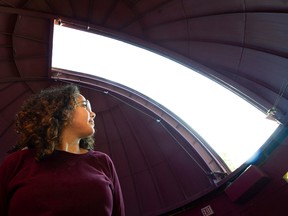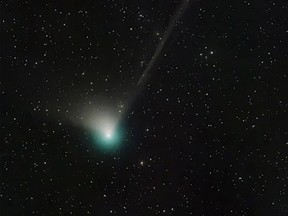Light pollution will make it very hard to see with the naked eye from Metro Vancouver, but it can be spotted in a dark sky around Feb. 1

Reviews and recommendations are unbiased and products are independently selected. Postmedia may earn an affiliate commission from purchases made through links on this page.
The green comet is coming. And no, we’re not talking about the latest Marvel movie.
This comet comes along a lot less often than that steady stream of superhero flicks. It will be visible from Earth around midweek — the first time that’s been the case in, oh, 50,000 years or so.
Start planning for your weekend with expert recommendations from our team of writers on what to cook, where to dine, and the perfect wine pairing delivered straight to your inbox on Thursday at noon.
Thanks for signing up!
A welcome email is on its way. If you don't see it, please check your junk folder.
The next issue of West Coast Table will soon be in your inbox.
We encountered an issue signing you up. Please try again
We asked H.R. MacMillan Space Centre resident astronomer Marley Leacock a few questions about how best to view the comet and other trivia about the infrequent visitor.
When is the peak time to view it, and will it be easily visible assuming clear skies in Metro Vancouver?
“The comet is closest to Earth on Wednesday, Feb. 1, and it should also be at its brightest,” says Leacock. But even at its brightest, the comet is “close to the limits our eyes can see in perfect dark sky conditions.”
Leacock says even if skies are clear that night, light pollution in Metro will make it very difficult to spot with the naked eye.
“Using binoculars or even a small telescope will help a bit, but getting away from the light pollution will give you better viewing.”

When will it be in the night sky?
“The comet’s location makes it circumpolar, so it will be in the sky all night,” says Leacock. “It is best viewed in the early-morning hours after the moon has set.”
Leacock says to look for it in the northern sky. “If you’re able to find Polaris, you’re not too far away from being in the general area of the sky where the comet will be.”
Why is the comet so rarely seen from Earth?
That’s due to its orbit, Leacock explains. “If the orbit is closed, the time it would take for it to complete one orbit around the Sun is about 50,000 years.”
Scientists are pretty sure the comet has passed Earth before — even if you’d have to check with an Ice Age Neanderthal to confirm that. What isn’t known is if it will stay in our solar system, or if “small gravitational impacts” will cause it to change its course, says Leacock.
Can it be spotted with the naked eye? If not, what would make viewing easier?
“It will be difficult to see with the naked eye if you are in the city,” says Leacock. She says the comet has a “magnitude” of about +5. By comparison, the Polaris star is at about +2, and even it isn’t easy to spot in the night sky. (The higher the magnitude, the fainter the object.)
“The limits our eyes can see with perfect conditions are about +3 magnitude in the city and about +6 in dark sky conditions,” she says. So beyond the city lights and with binoculars or a small telescope is your best bet.
Can you explain why it’s considered a ‘green’ comet?
“The green colour is due to diatomic carbon being broken down by solar ultraviolet light,” Leacock explains. “The light will destroy the molecules before they have time to leave the coma — the part around the nucleus of the comet — and go into the tail, so the comet gets a greenish colour.”
What is its full name and where is it from?
Comets like C/2022 E3 (ZTF) come from the Oort cloud, a spherical layer of icy objects surrounding our solar system.
Finally, we didn’t check with Leacock about this, but just for the record: No, C/2022 E3 (ZTF) is neither a new Tesla model nor one of Elon Musk’s kids.


